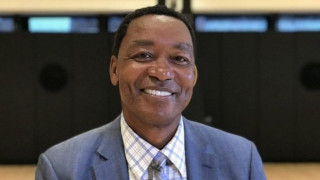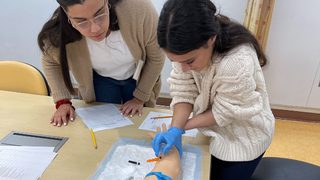Basketball Hall of Famer Isiah Thomas Inspires Students in Exclusive Discussion
Thursday, October 19, 2023

Isiah Thomas speaks at the Stillman School of Business
It isn’t every day that a bona fide legend comes to your college campus to speak to and inspire students with stories of hope, hardship and history. With many professors and administrators having a plethora of experience in the sports management and media world, this becomes a lot more imaginable when you attend Seton Hall.
A 12x NBA All-Star, 2x NBA champion, though the man himself stated it “should’ve been three,” a Finals MVP, 5x All-NBA teamer, and a member of the NBA’s 75th Anniversary Team, Isiah Thomas’s successes reach beyond the hardwood with the Indiana Hoosiers and the Detroit Pistons. Also known as “Zeke,” his story begins in the early 1960s in the West Side of Chicago.
Growing up as one of 12 children was not easy for Thomas, though his mother Mary Thomas was a very prominent figure in their neighborhood. Thomas’s mother worked with Fred Hampton and the Black Panthers as the Civil Rights movement was happening, with Thomas noting she had also marched with Martin Luther King, Jr.
“Everybody respected her. There’s actually a street named after my mom on the West Side of Chicago. They [even] made a movie about my mom,” Thomas recounted about his mother.
Thomas added that many would notice that he was Mary Thomas’s son and that “she got a pass…because my mom was so strong and befriended and helped so many people.”
Having experienced all of this so early in life, Thomas noted that many believe he wanted to be an NBA player or always dreamed of being an NBA player, though the Pistons legend relayed “the NBA wasn’t even on television when [he] was growing up.”
His basketball journey started by playing with the local Catholic Youth Organization thanks to his brother Lord Henry, as those who played on the team were fed. As the youngest, Thomas was seemingly forced to go with all of his older siblings and, eventually, that seemed to work out for him.
Though this did lead Thomas to attend Indiana University and play for Bobby Knight, he noted it wasn’t where he wanted to be initially. His mother was the one that made the decision for him at the press conference after Knight promised three things: he would teach everything he knew about basketball, guaranteed Thomas would graduate from college, and that Thomas would be a gentleman.
Thomas didn’t immediately finish his degree, having declared for the NBA draft early due to hardship, but did end up accomplishing what Knight had promised.
Thomas signed a contract with his mother due to his parents’ prioritization of education, which made him go back to school every summer to finish his degree, but having played in Detroit, he had to take correspondence courses at Groves High School in Michigan.
As soon as he entered the league in 1981, the NBA was perceived as “drug infested,” its ratings were poor, the value of franchises was at an all-time low, and, as former NBAPA Executive Director and current Director of the Center for Sports Management at Seton Hall, Charles Grantham put it, “too black for Madison Avenue.”
Thomas stepped up and became a player representative as a part of the NBA Players Association. He went on to be the president of the players’ union, working alongside Grantham, to continue his excellent leadership off the court and involve himself with the organizational side of the game.
Bottom of Form
He worked tirelessly with the players’ union to reshape the identity of the league, from stricter drug policies to attempting to give affected players a second chance.
Involvement in all of this brought Thomas great friendships with other NBA legends such as Magic Johnson and Larry Bird, who would work out together and share their knowledge about basketball, however Thomas noted that there is a clear difference in the game today.
“We come from a generation where the game is meant to be told,” Thomas said. “[You’ve] been tricked and they tell you the game is meant to be sold.”
Grantham said he knew there was one thing that most students were eager to hear about, despite Thomas’s many other ventures: the relationship with Michael Jordan and the Chicago Bulls.
“I didn’t know that I had a rivalry with MJ…My [rivals] were Magic Johnson and Larry Bird,” Thomas said. Considering that much of his career came between 1980 and 1990, before Jordan had made an NBA finals appearance, students and administration nodded as though they agreed, even if Michael Jordan is considered one of the greatest of all time.
“I never knew Michael Jordan felt the way about me until The Last Dance, when I saw it on television…He and his producers called and said we need you to do a story with Jordan…I thought we competed, but again, my focus was, ‘How do I beat Magic [Johnson] and Kareem [Abdul-Jabbar], and how do I beat [Larry] Bird, [Robert] Parish, [Kevin] McHale, and all of them?...He comes on television and says, ‘I hate you.’”
This connection with other stars and, at the end of the day, competitors allowed Isiah Thomas to gain advantage and capitalize on what he had learned. The Pistons teams of the late 1980s and early 1990s were donned “The Bad Boys” due to their unconventional style of play and composure compared to what the NBA was already used to.
Thomas stated, “Everything that we did went against the grain of the NBA…We were the first team to start our own jersey colors…We were the first to experiment outside of the NBA…It’s called cross-marketing now, we did that with the Oakland Raiders.”
Many see a collaboration of that nature to be common with how many brands utilize this tactic today, however this was more important for the NBA than one could expect.
“We were the first team to stay at five-star hotels…to get our own private plane for travel,” Thomas said, as he saw first-hand that owners got this treatment despite not putting their bodies on the line night-in, night-out.
This prioritization of player health and safety was a product of Isiah Thomas and the Detroit Pistons promising that these enhancements would help win more games. His focus was always winning, regardless of the opponent or venture outside of basketball.
In 1992, Thomas became the first NBA player to be on the cover of Forbes magazine thanks to his purchase of a company called American Speedy Printing. Beyond that, the NBA looked to expand internationally with teams in Vancouver and Toronto, the latter in which Isiah Thomas helped co-found upon his retirement.
The focus on the enhancement of player health never faded for Thomas, relaying that “everything you see about the Toronto Raptors today, we did…First team to have chefs, massage therapists, everything you see in today’s NBA.”
An all-time great player, developer, and businessman, his involvement with basketball didn’t have an end yet. In 2003, Thomas agreed to become the head coach, general manager, and President of Basketball Operations of the New York Knicks all at once. Despite a lack of success with the team through the mid-2000s, Thomas was pivotal in providing a clean slate for a team that was much worse off when he inherited it.
Outside of basketball’s organizational side, Thomas is an entrepreneur with his business, Isiah International, which works mainly outside of the US because of how he gets to work as an American rather than a minority as Thomas put it.
The firm invests in companies with strong market positions and growth potential. His ability to set his immediate family up with these investments, alongside working with many different backgrounds and cultures has given Thomas a new outlook post-basketball.
The accolades speak for themselves. Isiah Thomas used his unmatched dedication and desire to learn to become not only a great basketball player, but a great mind, friend, father, businessman, and human. The legacy that Thomas has produced is other worldly, though his story is not yet done.
Categories: Business






